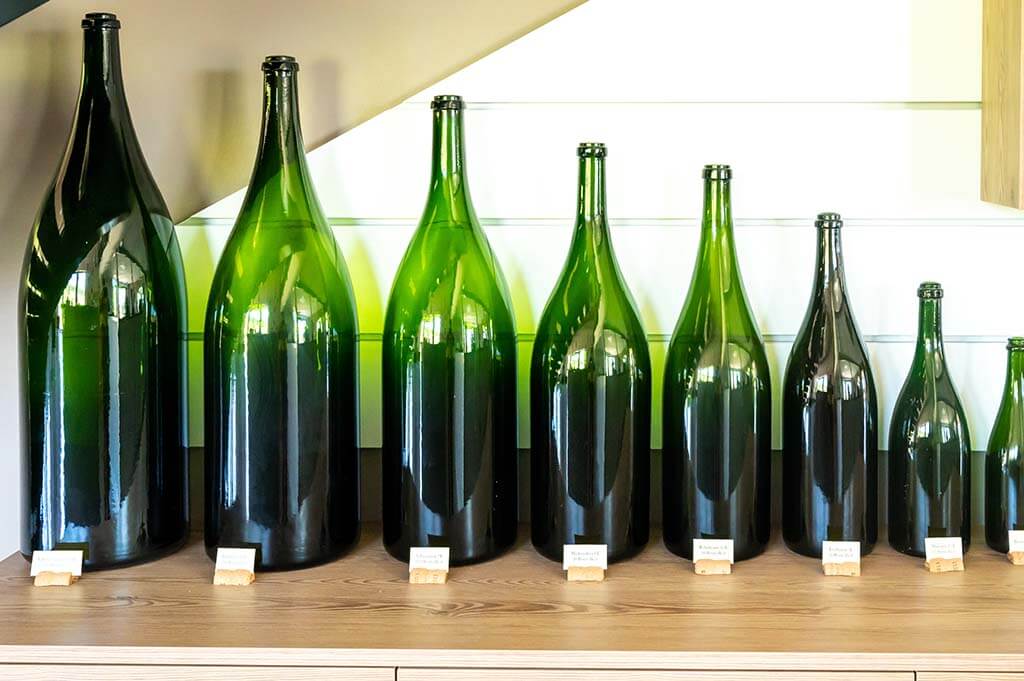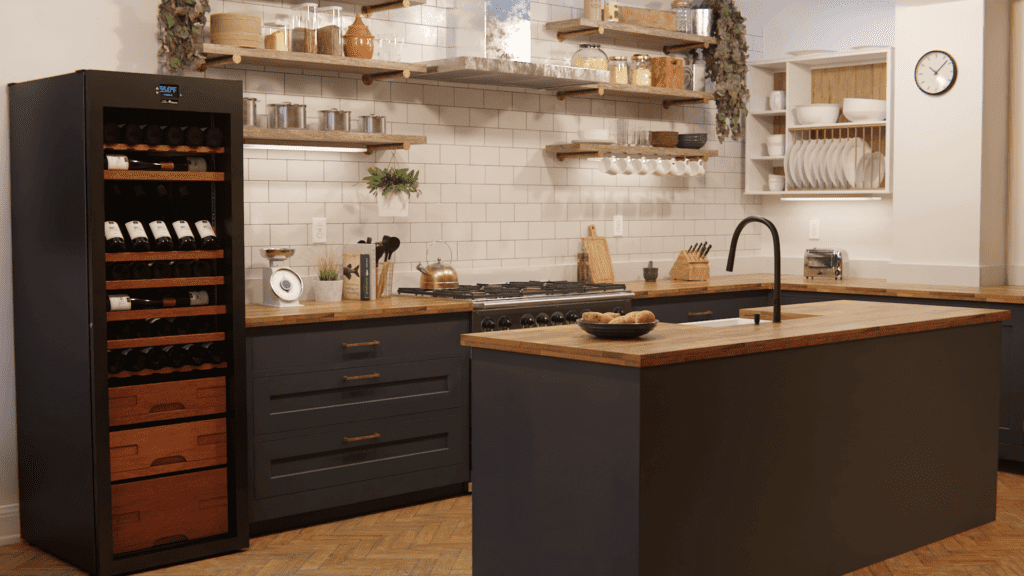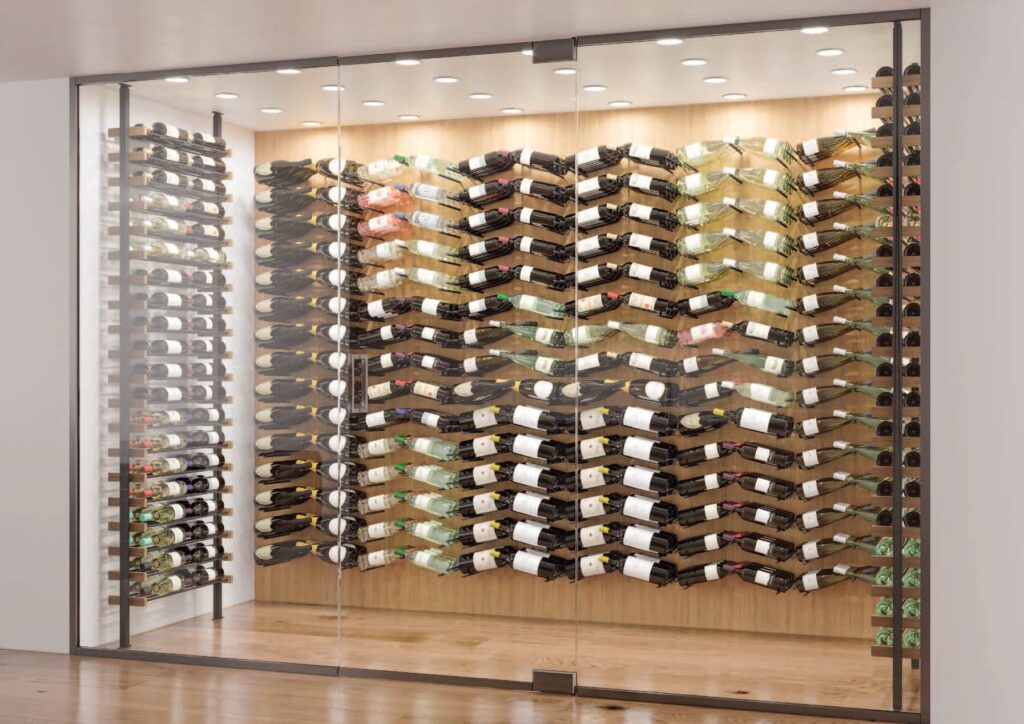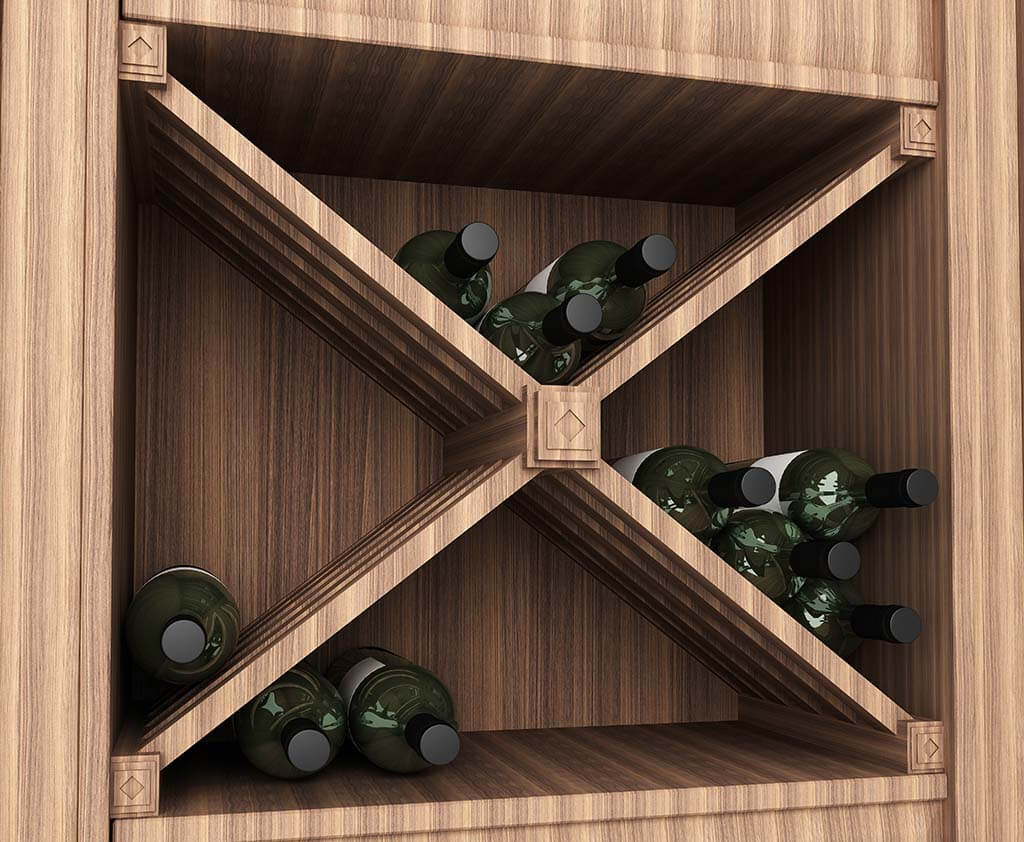Wine has been made for over 10,000 years. And through the ages, humans have stored it in almost everything imaginable, from animal skins to clay pots, to wooden barrels and, of course, glass bottles.
Even though glass is the modern standard, there isn’t one universal format. Almost 20 different types of bottles are used around the world, and they range in size from something you could fit in a purse to something you’d need a walk-in closet to store!
Many savvy wine collectors seek out these rare and unusual formats. So, how and where do the pros store their odd-sized bottles? The answer is in a custom-designed wine cabinet, display or cellar.
Common Wine Bottle Sizes

The two most common size bottles in commercial use today are the Standard (750 ml) and the Magnum (1.5 L). You could hypothetically spend an entire lifetime drinking wine, and these would likely be the only two bottle sizes you’d see. However, it should come as no surprise that even the “Standard” is not so standard; the Burgundy version is slightly larger in outside diameter than the Bordeaux.
Rare formats can be a lot of fun to collect and serve, especially at gatherings. And the larger vessels actually serve another purpose: with less air exposure, bold red wines can age slowly for decades, if not longer.
Of the 17 different sizes in use, here are most popular:
| Name | Volume | # of Standard Bottles | # of 5 oz Glasses |
| Split | 187.5 ml | ¼ bottle | 1 |
| Demi | 375 ml | ½ bottle | 2.5 |
| Jennie | 500 ml | ¾ bottle | 3 |
| Bordeaux (Standard) | 750 ml | 1 bottle | 5 |
| Burgundy | 750 ml | 1 bottle | 5 |
| Magnum | 1.5 L | 2 bottles | 10 |
| Double Magnum or Jeroboam | 3 L | 4 bottles | 20 |
| Bordelaise Jeroboam | 4.5 L | 6 bottles | 30 |
| Imperial or Methuselah | 6 L | 8 bottles | 40 |
| Salmanazar | 9 L | 12 bottles | 60 |
| Balthazar | 12 L | 16 bottles | 80 |
| Nebuchadnezzar | 15 L | 20 bottles | 100 |
You’ve probably noticed, many of the formats are named after Biblical kings! Nobody is certain where this trend began but some theorize that because wine was historically made by monks in monasteries, the names provided a familiar system.
Tips for Storing Different Size Wine Bottles
Not all wines are built to last, and so large format bottles are only reserved for the most exceptional producers and vintages. Wines of this caliber require storage and aging in optimum conditions to bring out their best.
With so many variations to contend with, versatility is key! From the glass to the interior lighting, to the racking, facing materials, temperature control options, etc., you want something personalized. A dedicated cooling unit that can be calibrated and serviced specifically for your needs is best, too.
The following three options are great for keeping odd-format bottles. The approach you choose depends on how much space you have, your budget and, of course, your personal taste.
Try a Wine Cooling Cabinet

There are typically two types of wine cabinets. The most popular and accessible are prebuilt cabinets/refrigerators. These are typically smaller systems with a metal exterior that can be purchased from online retailers.
The other type of cabinets are fully customized self-contained units designed to be integrated into almost any existing space. They can be built to fit a wall, nook or corner, or as a stand-alone piece that blends with the home’s décor. Both types are excellent options for those who need something compact for a smaller collection.
Wine Guardian cabinets are one of a kind because they allow for shelving personalization within a preconstructed cabinet. All combined, Wine Guardian cabinets offer over 1,000 different variations! Our cabinet configurator tool allows you to space the distance between shelves for any combination of Burgundy and Magnum bottles, enabling you to store different sizes, all within one self-contained system.
Furthermore, you can expect full attention to detail with included features like temperature control, UV protection, charcoal filtering, automatic defrosting and vibration-free design.
Design a Wine Display

Large-format wine bottles are quite a spectacle; by nature, they beg to be seen. A wine display doesn’t hide and isn’t shy! Displays are a great way to make use of unique or asymmetrical spaces and serve as a focal point in the interior design.
You’ll often see displays in restaurant and hospitality settings, but at home, they’re even more poignant. Imagine an illuminated showcase in an entryway or under-stairs wine space as a centerpiece in your great room or as a wall feature that pulls separate spaces together.
As with anything bespoke, expect to pay more. Anything custom is probably going to run you triple the price of something standard.
Construct a Wine Cellar

If you’re thinking about building a full-sized wine cellar, you probably have a fair amount of room to spare, in which case you can dedicate spots for those larger-than-life bottles.
While some collectors display their Magnums and Jeroboams simply standing upright on the floor, in a nook or on a shelf, it’s always better to store luxury wines at an angle or on their side.
The traditional solution is cube shelving with quadrants: this approach is practical because it accommodates all sizes. But for something a little more modern and catchy, there are columnar wall-mounted racks. And for the largest formats, you can even buy or commission individual bottle cradles.
Many collectors admire the beauty of wooden wine cases and like to store their bottles in their original boxes. A simple shelf around the foot of the room, a knee wall or pull-out drawers are all creative ways to incorporate these as part of the storage solution.
How Wine Guardian’s Wine Cooling Cabinets Help Store Different Wine Bottle Sizes
As you can see, there is some overlap with these options. Wine cabinets can also be displays, displays can also be cellars and cellars can incorporate all of these features. It’s in the way that you use it; that’s the beauty of taking a custom approach.
When it comes to collecting and aging odd-format bottles, or even just (the two) standard sizes, your storage space needs to be customizable, versatile and — most importantly — provide a reliable, stable environment that both protects your investment and brings out its best when it’s time to pull the cork.
Whether you choose a cabinet, display or cellar, Wine Guardian has you covered! At the heart of all these options you’ll find Wine Guardian cooling and humidity control technology — the best in the industry — providing unwavering, long-term temperature and humidity control for the serious wine lover.
Whether you’re just getting started or looking for more space to expand and display your existing collection, a Wine Guardian wine cabinet is a great solution! To develop these cabinets, we partnered with La Sommelière, a European manufacturer with years of experience in the wine cabinet industry. You’ll get the technology, features and options of a full wine cellar within a self-contained and movable unit. Start here with our new cabinet configurator tool to explore the possibilities.

